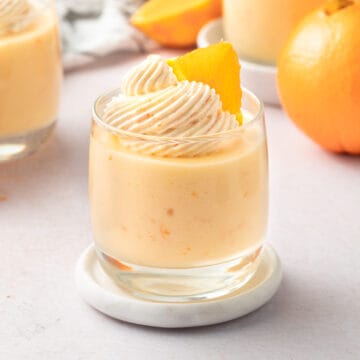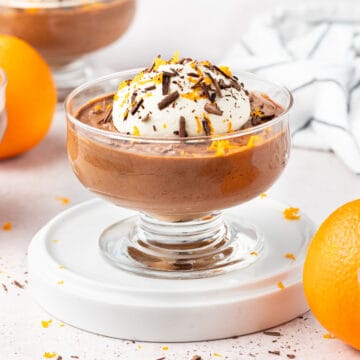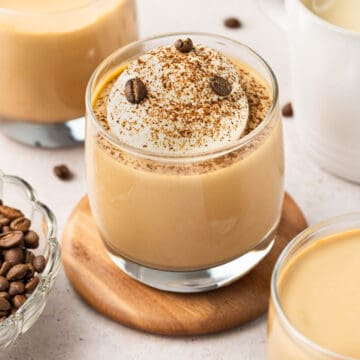This Vanilla Mousse recipe is easy to make with a few ingredients only. The mousse is deliciously light in texture yet rich in taste and packed with fresh vanilla bean flavours. It is a great make-ahead dessert for a special occasion or a dinner party.
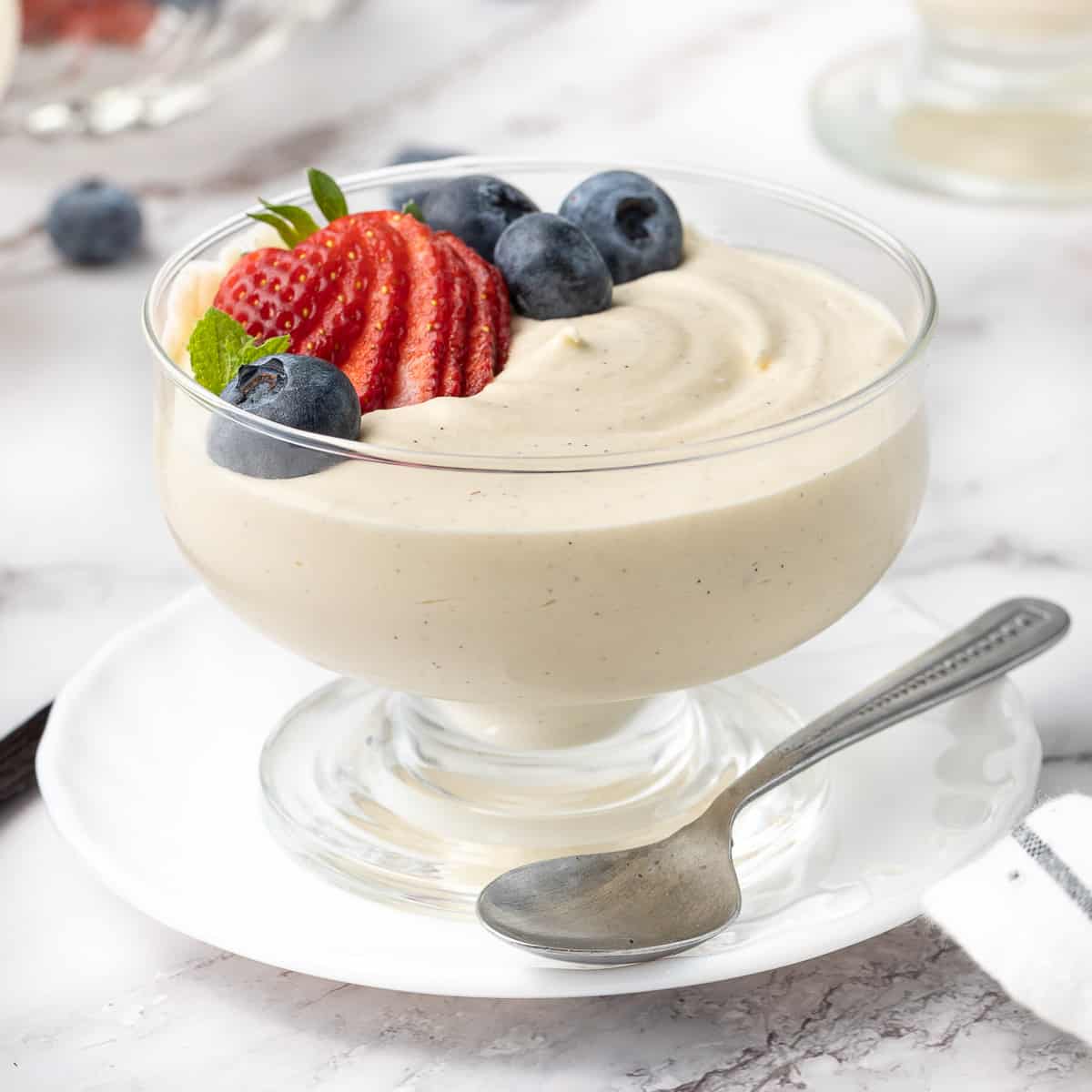
Jump to:
Why we love this recipe
These easy whipped vanilla mousse cups are a luscious dessert that is simple to make - and packed with fresh vanilla bean taste. With its many toppings options, it is a versatile dessert and delicious treat that is perfect for a special occasion or dinner party!
Rather than preparing a custard base and folding in whipped cream, this vanilla mousse recipe is made from a sweetened vanilla bean custard that contains a high ratio of cream and whole eggs.
The whole vanilla custard mixture is lightly whipped to create a deliciously decadent dessert. No need to fold a whipped cream mixture into a custard here, and no gelatin required either! Once chilled, the mousse becomes light and amazingly rich and fluffy.
What is a mousse
The word "mousse" means foam or froth in French. A mousse is a dessert or frosting made from combining a whipped element (either cream or egg whites) with a flavoured base (a pastry cream here). It is usually made from very simple ingredients like eggs, sugar and milk and/or cream.
Once chilled, it sets into a delicious fluffy and airy mixture that is truely irresistible. They can be served as an individual dessert or used as a component of a larger desserts like layered cakes or tarts.
There are many different ingredients used to flavour a mousse, such as a chocolate mousse, fruit mousse like my Raspberry Mousse and Lemon Mousse or even a Coffee Mousse.
Ingredients
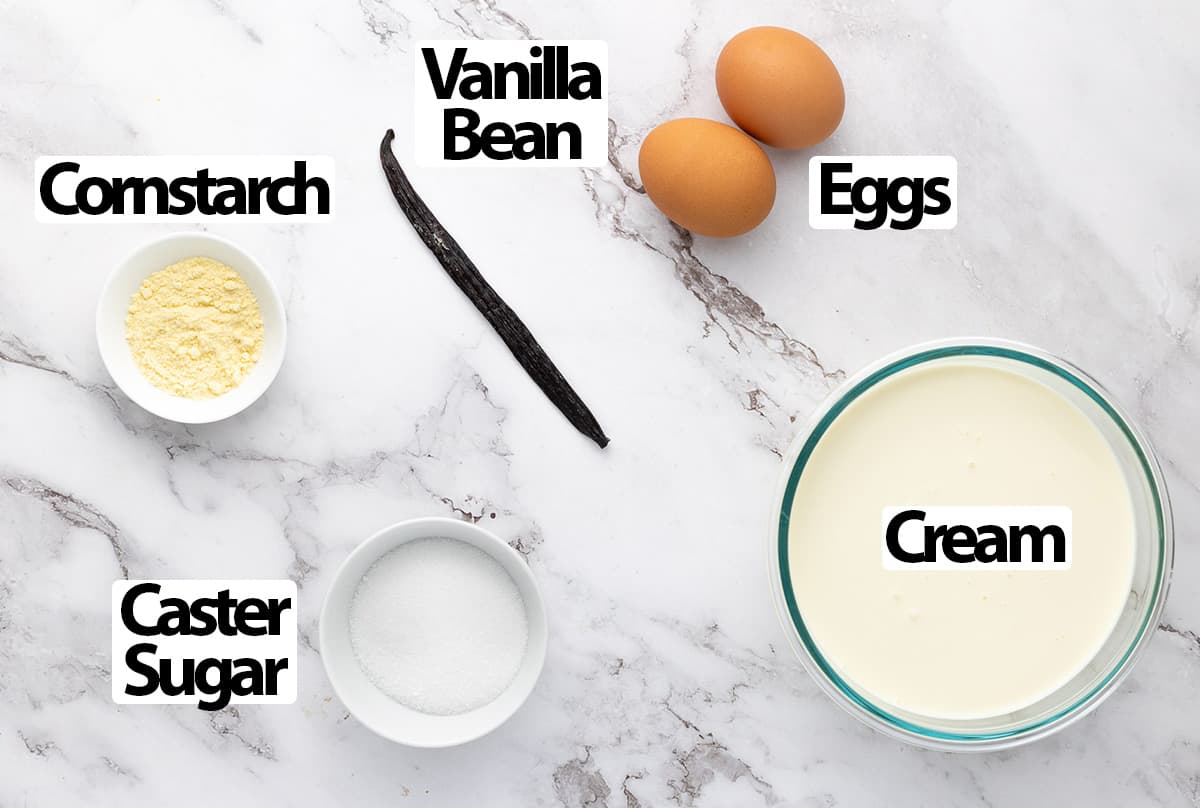
Scroll down to recipe card below for all quantities
What is vanilla mousse made of:
- Cream: thickened / heavy cream (heavy whipping cream or double cream in the UK). Make sure to use a cream that contains at least 30% fat or the whipped cream won't be stable enough and will deflate.
- Vanilla: this is a recipe where using a fresh vanilla pod is really worth it! Alternatively, you could use vanilla paste. Although vanilla extract or vanilla essence will work, you won't get the same natural vanilla flavour.
- Eggs: large eggs, at room temperature. Make sure the eggs don't come straight from the fridge or they might curdle when you mix in the warm cream. We are using whole eggs here, not just the egg yolks like you would to make Pastry Cream.
- Sugar: caster sugar, or superfine white sugar. You can use regular white granulated sugar; I personally like to use caster sugar as it will dissolve more quickly in the cream.
- Cornstarch: used to thicken the custard. You can substitute it with plain / all-purpose flour or another starch such as tapioca starch or arrowroot starch.
How to make Vanilla Mousse Cups
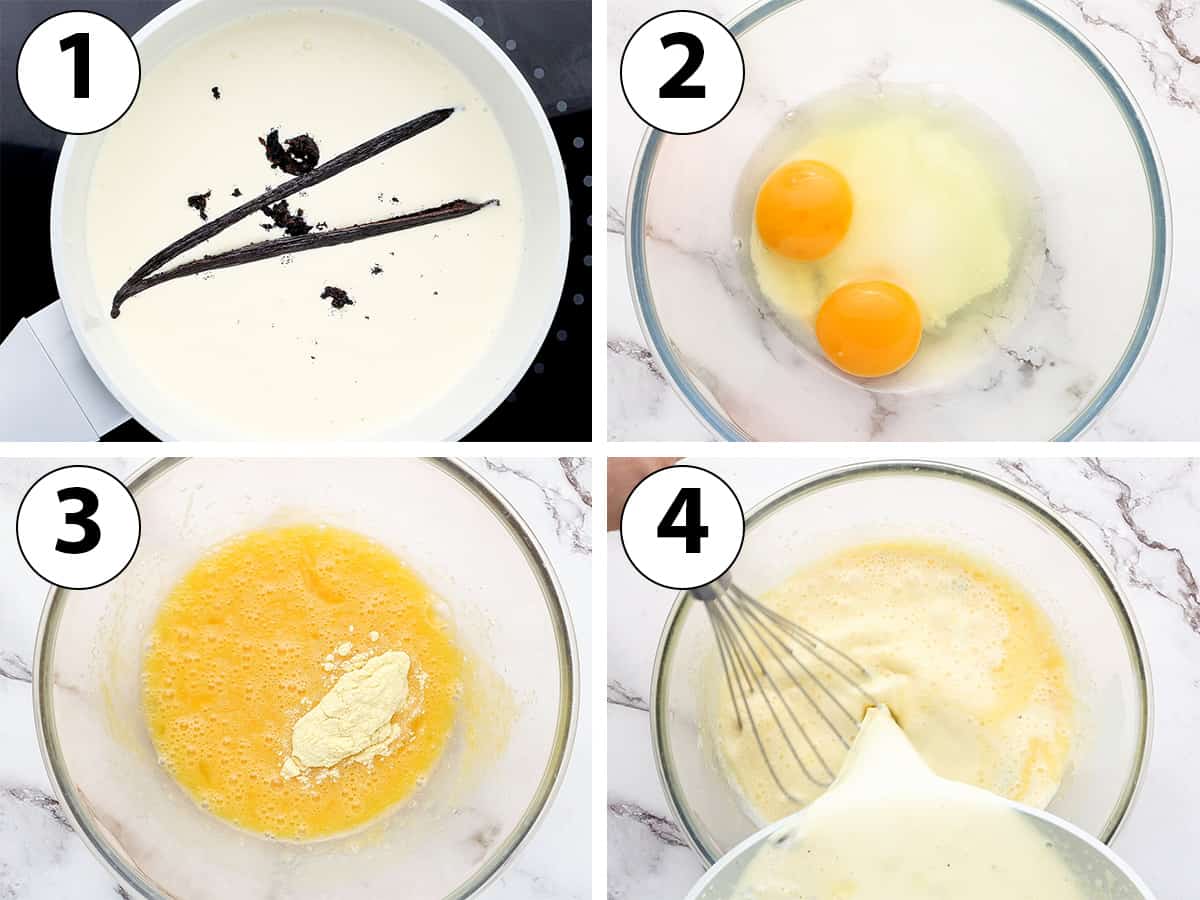
Start by preparing the vanilla bean custard:
- Photo 1: Pour the cream in a medium to large saucepan. Slice the vanilla bean in half and scrape off the seeds with a small parring knife. Put both the seeds and the remaining vanilla pod in the saucepan.
- Stir to combine then heat up on low heat until it starts to simmer. Once it simmers, turn off the heat, cover with a lid and set aside to infuse for 10 to 15 minutes.
Make sure to not let the cream boil; a simmer is enough here. If you are using vanilla paste, there is no need to let the cream infuse.
- Photo 2: In the meantime, place the sugar and eggs in a large bowl. Whisk for about a minute to combine.
- Photo 3: Mix in the cornstarch until smooth.
- Photo 4: Remove the vanilla pod from the warm cream (and keep to make homemade vanilla extract for example). Slowly pour the cream over the egg mixture while whisking. Whisk well until completely smooth.
This step is called "tempering the eggs". It allows to slowly rise the temperature of the eggs to avoid a sudden change of temperature that could make the egg curdles or burn.
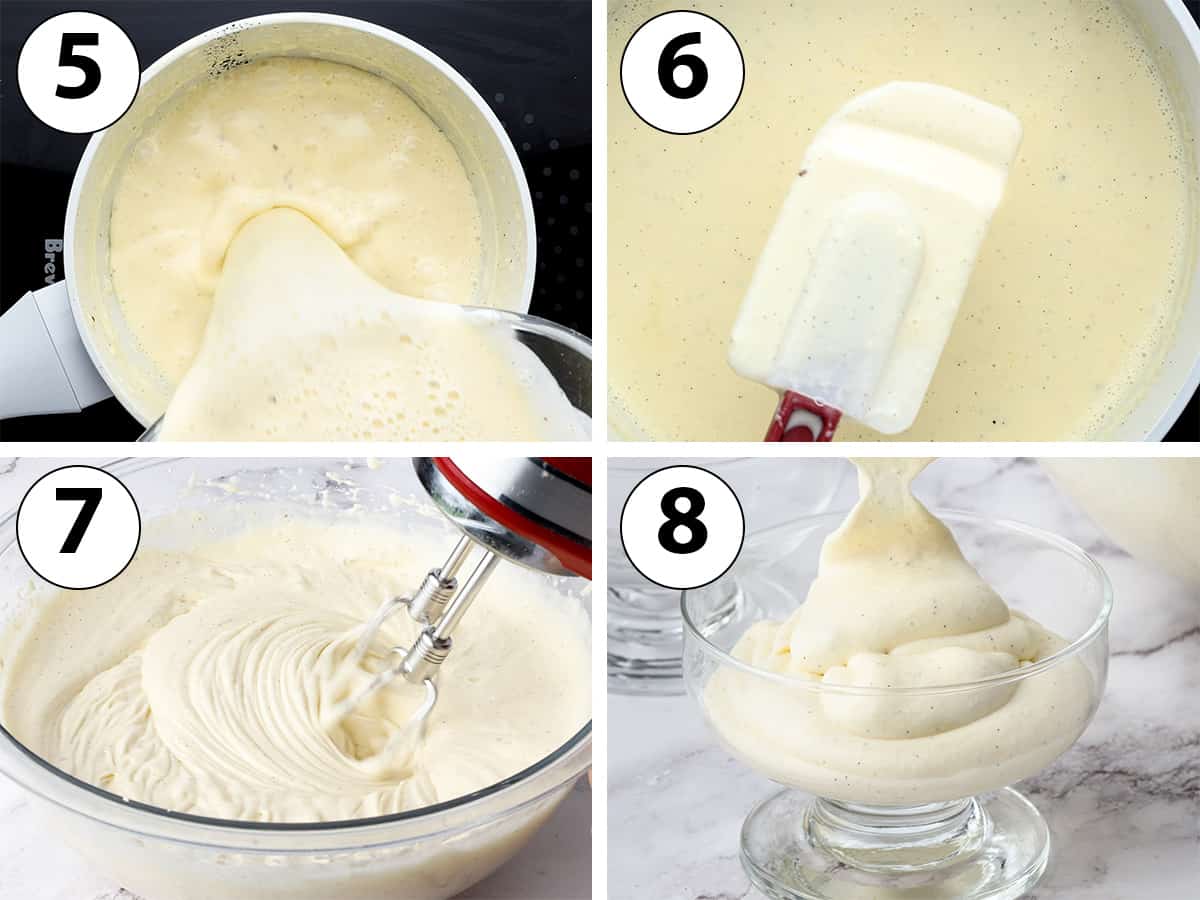
- Photo 5: Pour the mixture back into the saucepan.
- Photo 6: Turn on low heat and cook for about 5 to 10 minutes (or until the custard has thickened) while continuously stirring with a heat-proof spatula.
The mixture should coat the back of a spoon or spatula and have reached 82 to 84 degrees Celsius (180 to 183 degrees Fahrenheit).
Make sure to keep the temperature on low; if the stove is too hot, you risk overcooking the eggs which will give you a gritty, lumpy custard.
- Transfer the cooked vanilla custard into a clean bowl or large airtight container. Cover with plastic wrap touching its surface and refrigerate for 1 to 2 hours, or until completely cool.
- Photo 7: Using an electric mixer (or in a stand mixer), start whipping the chilled custard on medium speed until soft peaks form. Slowly increase to high speed and keep whipping until you get medium to stiff peaks.
It is better to under-whip than over-whip the mousse here. You can stop at medium peaks if you want a lighter dessert, or continue to stiff peaks for a stiffer, more stable vanilla mousse.
- Photo 8: Pour the whipped vanilla mousse into serving cups and refrigerate for at least 3 hours - preferably overnight. Make sure to be gently with the mousse to avoid deflating it.
- Decorate with your choice of garnish before serving.
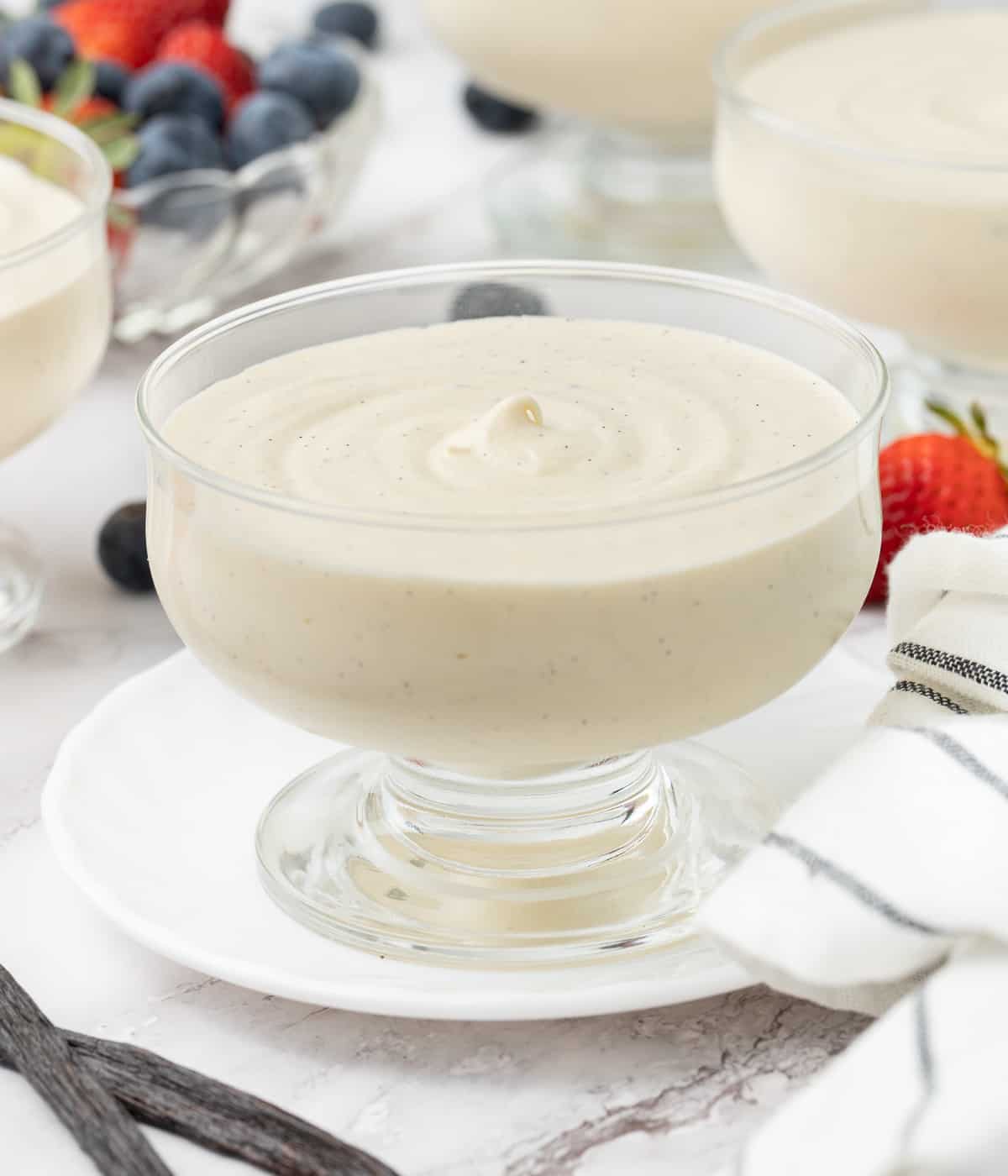
Recipe FAQs
The name comes from the French word "mousse" (or verb "mousser") that means foam or froth (and the verb "to froth" or "to foam"). It simply refers to the the airy and light texture of a typical mousse dessert that is made of tiny air bubbles.
Whipped cream is simply a cream that is vigorously whisked to create tiny air bubbles that give it a distinctive light, airy consistency. The high content of fat in the cream (min 30%) helps to stabilise those air bubbles as they wrap around them.
A mousse usually contains other ingredients that give the dessert a richer taste and distinctive flavour. Traditional mousse are made from a flavoured based (fruit puree or chocolate for example) that is combined with either whipped cream or whipped egg whites.
I highly recommend using fresh vanilla for the best flavour here - but you could use vanilla bean paste if preferred. Vanilla extract will work, but the flavours won't be as strong and you won't get the gorgeous black specks of vanilla.
This vanilla mousse is rather soft since we want a super light and airy dessert. To use as a cake filling that is more stable, I recommend adding a little bit of gelatin to help thicken the cream.
The recipe can be used as is to fill desserts such as Choux au Craquelin and Brioche Donuts or to use as a tart filling.
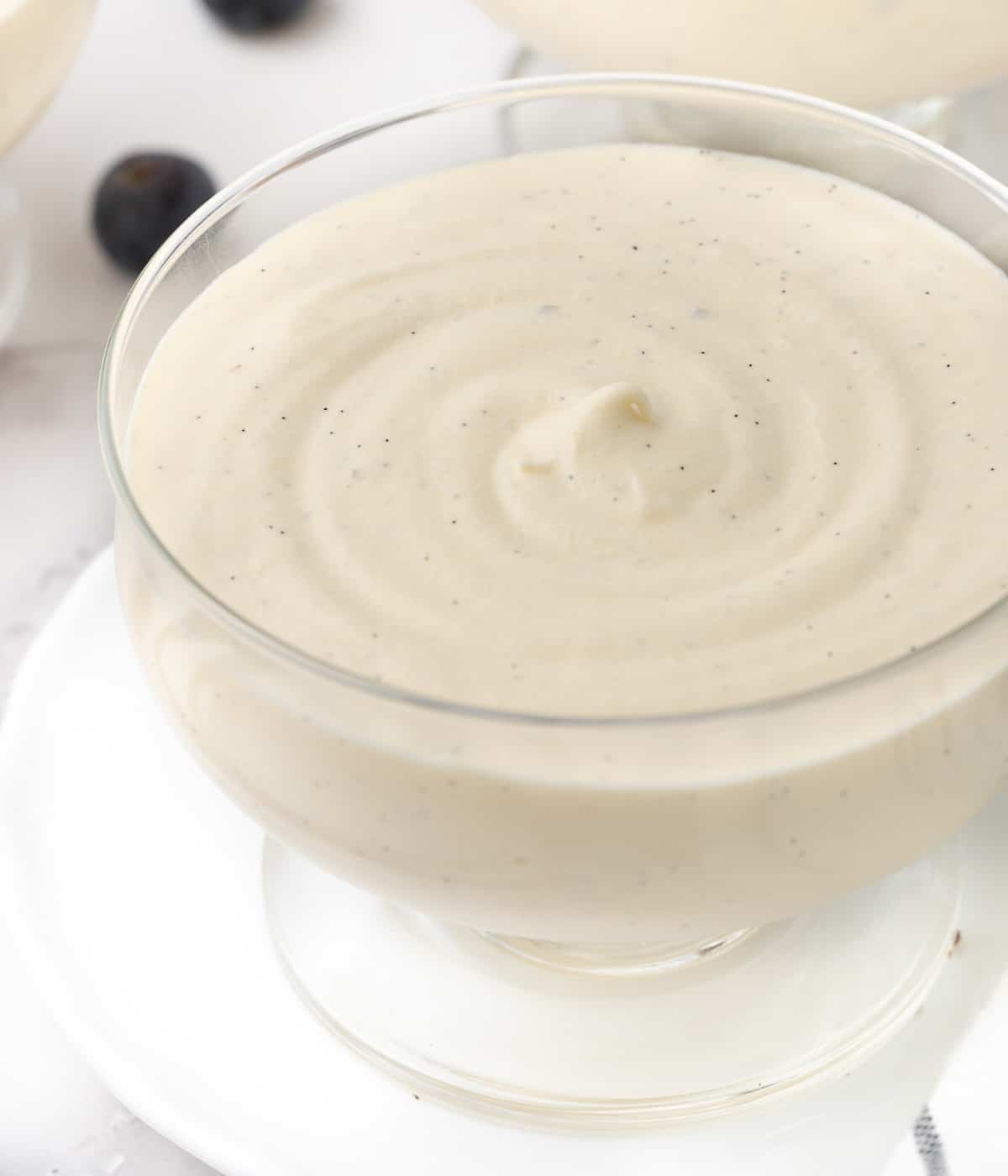
Tips & Troubleshooting
- How to know the custard base is cooked: there are two ways to check if your custard is cooked. First, with the "coating" method where dip the back of a spoon or a spatula in the cooked cream and look at the consistency. If the mixture is very liquid and drips straight off, it is not ready. It the mixture is thick enough to coat the spatula and you can draw a clear line with your finger, it is ready. Second, check the temperature of the custard: it is cooked at 82 to 84 degrees Celsius (180 to 183 degrees Fahrenheit).
- Why is my custard lumpy or curdled? If the stove temperature is too high (or a change of heat that is too sudden), the eggs will overcook and start to scramble, leaving you with a curdled custard. You can pour the mixture through a thin mesh sieve to remove small lumps or use an immersion blender to smooth it out.
- The vanilla mousse isn't setting: if the custard was under-whipped or over-whipped, it will not set correctly and you will be left with a thin cream consistency. Make sure to also give plenty of time for the mousse cups to set - preferably overnight for the best results.
Serving Suggestions
The easy vanilla mousse recipe can be served plain on its own or topped with a layer of fresh fruit or chocolate shavings. There are many delicious toppings or base layers that can be added to customise the dessert.
Topping Ideas:
- Fruit Coulis: Raspberry Coulis, Strawberry Coulis, Blueberry Coulis, Passion Fruit Coulis, Mango Coulis.
- Fruit Compotes: Mixed Berry Compote, Peach Compote Strawberry Compote, Blueberry Compote, Pear Compote, Cherry Compote or Stewed Rhubarb.
- Curds: Orange Curd, Lemon Curd or Passion Fruit Curd.
- Chocolate: like a chocolate sauce or chocolate shavings,
Base Layer ideas:
- Crumbed cookies like Sablés Bretons, Biscoff Cookies or Graham Crackers.
- A simple sponge cake to make individual trifle jars.
Storing & Freezing
These vanilla cups should be stored in the fridge and are best served within two days. If not served straight away once set, make sure to cover each cup with plastic wrap or foil to avoid drying out.
This dessert should not be frozen.
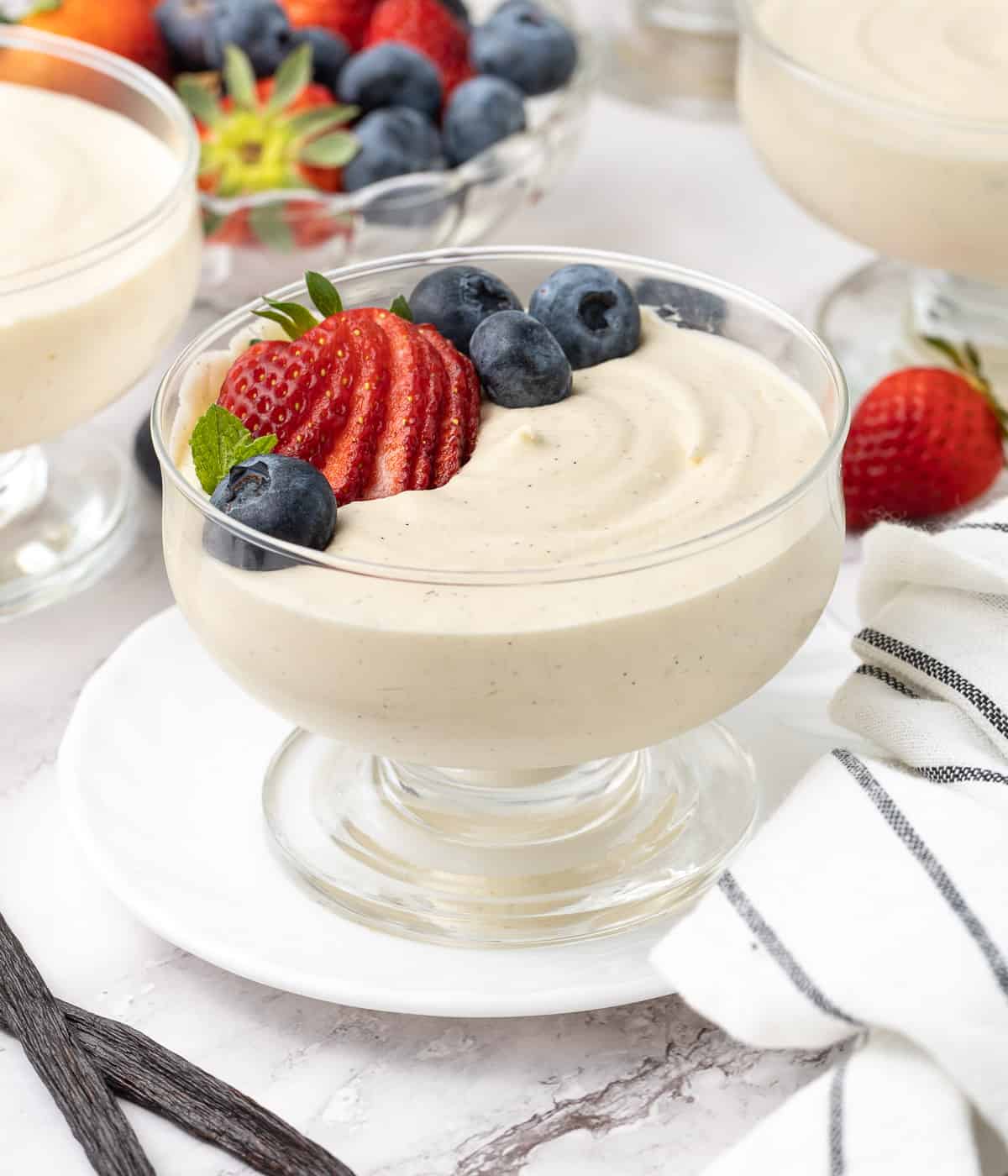
Made this recipe?
Let us know if you liked it by leaving a comment below, and tag us on Instagram @a.baking.journey with a photo of your creation!
Recipe
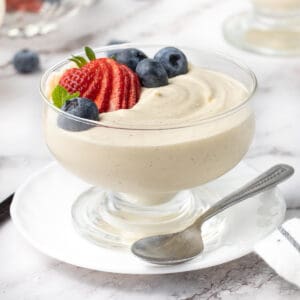
Easy Vanilla Mousse Cups
Ingredients
- 600 ml Thickened Cream / Heavy Whipping Cream - min. 30% fat content
- 1 fresh Vanilla Bean Pod - or 2 teaspoon vanilla paste
- 40 gr Caster Sugar
- 2 large Eggs - at room temperature
- 8 gr (1 tablespoon) Cornstarch
Disclaimer
I highly recommend using the measurements in grams & ml (instead of cups & spoons) for more accuracy and better results.
Instructions
- Pour the cream in a large saucepan. Slice the vanilla bean in half and scrape off the seeds with a small parring knife. Put both the seeds and the remaining vanilla pod in the saucepan. Stir to combine then heat up on low heat until it starts to simmer. Once it simmers, turn off the heat, cover with a lid and set aside to infuse for 10 to 15 minutes.
- In the meantime, place the sugar and eggs in a large bowl. Whisk for about a minute to combine, then mix in the cornstarch.
- Remove the vanilla pod from the warm cream (see note 1) then slowly pour the cream over the egg mixture while whisking. Continue to mix until completely smooth (see note 2).
- Pour the mixture back into the saucepan. Turn on low heat and cook for about 5 to 10 minutes while continuously stirring with a heat proof spatula. Cook until the mixture has thickened without letting it boil (see note 3).
- Transfer the custard into a clean bowl, cover with plastic wrap touching its surface and refrigerate for 1 to 2 hours or until completely cool.
- Using an electric mixer (or in the bowl of a stand mixer fitted with the whisk attachment), whip the chilled custard on medium speed until soft peaks form. Then slowly increase to high speed and keep on whipping until you get medium to stiff peaks depending on the texture you are after (see note 4).
- Gently pour the mousse into 4 (for large desserts) or 6 (for small desserts) serving cups and refrigerate for at least 3 hours - preferably overnight. Serve plain or garnish with your choice of topping once completely set.
Tried this recipe? Make sure to leave a comment and star rating below!
Notes
- Keep the leftover vanilla pod to make homemade vanilla extract for example.
- This step is called "tempering the eggs". It allows to slowly rise the temperature of the eggs to avoid a sudden change of temperature that could make the egg curdles or burn.
- The mixture should coat the back of a spoon or spatula and have reached 82 to 84 degrees Celsius (180 to 183 degrees Fahrenheit).
- It is better to under-whip than over-whip the mousse here. You can stop at medium peaks if you want a lighter dessert, or continue to stiff peaks for a stiffer, more stable vanilla mousse.


